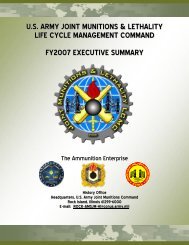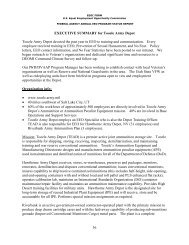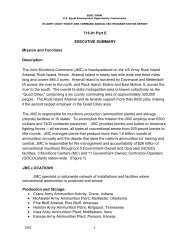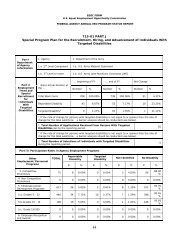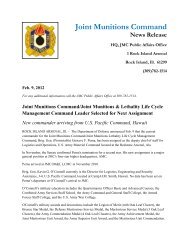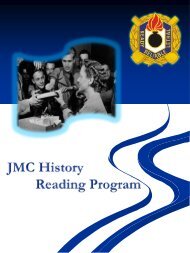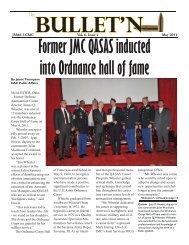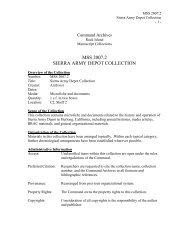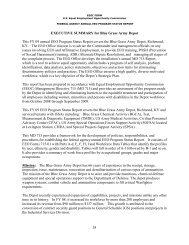History of the Ammunition Industrial Base - JMC - U.S. Army
History of the Ammunition Industrial Base - JMC - U.S. Army
History of the Ammunition Industrial Base - JMC - U.S. Army
You also want an ePaper? Increase the reach of your titles
YUMPU automatically turns print PDFs into web optimized ePapers that Google loves.
costs. There was minimal incentive for capital investment in new technology and <strong>the</strong> base was<br />
underutilized at 26%. After September 11 th , 2001, it was expected that homeland defense,<br />
Continental Operations (CONOPS), and training surge would place greater demands on <strong>the</strong><br />
base. 163 Some <strong>of</strong> <strong>the</strong> issues faced were problems with critical end items or components. In 2001,<br />
<strong>the</strong>re was only one ammunition links manufacturer for small and med caliber items. There was<br />
no source for <strong>the</strong> M67 grenade body. It was projected that TNT facilities would take $28 million<br />
and 18 months to reactivate. Several critical commodities were without domestic sources.<br />
Examples include nitroguanidine - essential to <strong>the</strong> Modular Artillery Charge System (MACS);<br />
lead azide used in 85% <strong>of</strong> munitions; baled cotton linters used in Hydra, 120mm tank rounds,<br />
and MACS; red and white phosphorous in smoke munitions; and M234 self destruct fuzes used<br />
in artillery, navy gun ammunition and missile programs. As it stood, <strong>the</strong> base could only affect<br />
10% <strong>of</strong> go to war shortfalls. The base had marginal capability for preferred and precision<br />
munitions but pushes to divest <strong>the</strong> organic base fur<strong>the</strong>r increased its fragility.<br />
The reasons why <strong>the</strong> base was in this particular state have been discussed. Inadequate<br />
funding, fluctuations in buys, and lack <strong>of</strong> long term commitment had not sustained <strong>the</strong> base or<br />
fostered investment. Affordability versus Warfighter needs drove policies. Focus on price<br />
versus price combined with readiness had decreased capabilities. While <strong>the</strong>se various studies<br />
come to some different conclusions and recommendations, <strong>the</strong>y are consistent in mentioning<br />
several key and continuing factors that have negatively impacted <strong>the</strong> ammunition base since <strong>the</strong><br />
end <strong>of</strong> <strong>the</strong> Cold War and throughout its history. All mention <strong>the</strong> steep reduction in requirements<br />
and even steeper drops in annual funding. They mention <strong>the</strong> relatively low priority <strong>of</strong><br />
ammunition in <strong>the</strong> DoD budget and <strong>the</strong> repeated use <strong>of</strong> ammunition dollars as a bill payer for<br />
o<strong>the</strong>r priorities. The reports discuss <strong>the</strong> loss <strong>of</strong> commercial firms in <strong>the</strong> munitions business, <strong>the</strong><br />
rising number <strong>of</strong> sole source suppliers, and <strong>the</strong> loss <strong>of</strong> a skilled workforce.<br />
Operation Desert Storm<br />
At <strong>the</strong> onset <strong>of</strong> Operation Desert Storm/Desert Shield (ODS) in 1991, only ten<br />
ammunition items were considered in short supply. All o<strong>the</strong>r ammunition items were at 100<br />
percent <strong>of</strong> <strong>the</strong> requirement, on hand or in transit to Southwest Asia (SWA). A strong inventory<br />
acquired and maintained over a significant period <strong>of</strong> years, made ammunition a success story in<br />
ODS. No inactive production facilities were brought into operation during <strong>the</strong> relatively brief<br />
conflict. Of <strong>the</strong> fourteen active ammunition plants thirteen participated in <strong>the</strong> supplying <strong>of</strong><br />
munitions during ODS.<br />
In total AMCCOM was responsible for around 181 varieties <strong>of</strong> conventional ammunition<br />
needed in SWA. 164 Planning for maximum rate production during ODS revealed <strong>the</strong> U.S.<br />
production base for mortar fuzes restricted production capability for most mortar ammunition<br />
rounds. Prior to initiation <strong>of</strong> <strong>the</strong> war in February 1991, a complete sustainability analysis had<br />
been conducted laying out <strong>the</strong> problems facing AMCCOM in terms <strong>of</strong> sufficiently supplying <strong>the</strong><br />
forces. According to <strong>the</strong> study, 106 <strong>of</strong> 152 items could sustain <strong>the</strong> fight for at least a year after<br />
commencement <strong>of</strong> actual hostilities and would be supplemented by fur<strong>the</strong>r production.<br />
163 MG Wade H. McManus, Jr. “<strong>Ammunition</strong> Support: Issues and Challenges” (OSC Briefing: ca 2002), Slide 12.<br />
164 AMCCOM is predecessor command <strong>of</strong> <strong>the</strong> Joint Munitions Command (<strong>JMC</strong>).<br />
53



